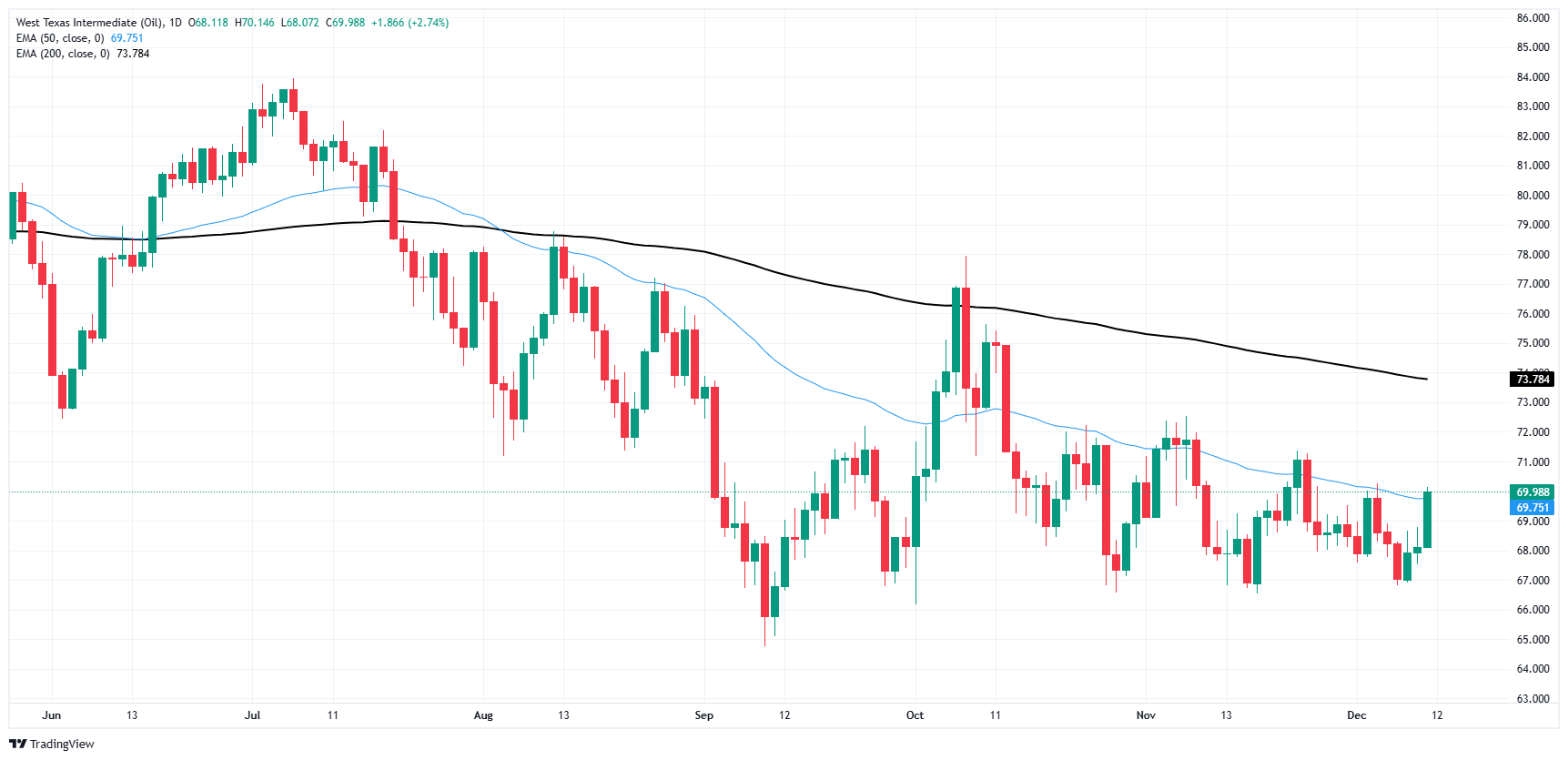Crude Oil rises on Wednesday, WTI taps $70 per barrel
- Crude Oil markets rallied to push WTI to $70/barrel.
- Barrel prices jumped after the EIA posted a larger-than-expected stocks drawdown.
- OPEC has lowered its global Crude Oil demand forecast, but China hopes remain.
West Texas Intermediate (WTI) Crude Oil prices rallied on Wednesday, jumping around 2.75% and clipping into $70 per barrel after the Energy Information Administration (EIA) reported a steeper drawdown in US Crude Oil reserves than energy traders anticipated. The Organization of the Petroleum Exporting Countries (OPEC) has lowered its forecasts for global Crude Oil demand growth, however barrel traders are still banking on growing energy demand from China to sop up the extra.
According to the EIA, US Crude Oil Stocks Change for the week ended December 6 fell by 1.425 million barrels, below the forecast -1.1 million and declining further from the previous week’s decline of over 5 million barrels. With US Crude Oil reserve drying up in the pipe, barrel traders found the buy button on the expectation that US processors will be forced to increase the pace of their market buying.
OPEC reduced its forecasts for global Crude Oil demand growth in the coming year, dragging the Crude Oil consortium’s lofty expectations closer in-line with the more demure forecasts posted by the EIA. OPEC now anticipates that global oil demand will increase by 1.61 million barrels per day in 2024, a reduction from last month's forecast of 1.82 million barrels. Additionally, for 2025, they have revised their growth estimate down to 1.45 million barrels per day from the previous 1.54 million barrels.
Crude Oil price forecast
Crude Oil prices have been traveling in a rough downside wedge since dipping below $66 per barrel in September. WTI bids, despite finding a technical floor below $68 per barrel, have been unable to decisively pierce above the 50-day Exponential Moving Average (EMA), and intraday price action is poised to continue battling the moving average in the near term.
Despite barrel prices seemingly held aloft of further downside pressure from a bidding zone just north of the $66 key handle, topside momentum remains limited, and Crude Oil bulls will continue to find themselves short-changed as swing highs continue to grind lower below the 200-day EMA near $73.80.
WTI daily chart
WTI Oil FAQs
WTI Oil is a type of Crude Oil sold on international markets. The WTI stands for West Texas Intermediate, one of three major types including Brent and Dubai Crude. WTI is also referred to as “light” and “sweet” because of its relatively low gravity and sulfur content respectively. It is considered a high quality Oil that is easily refined. It is sourced in the United States and distributed via the Cushing hub, which is considered “The Pipeline Crossroads of the World”. It is a benchmark for the Oil market and WTI price is frequently quoted in the media.
Like all assets, supply and demand are the key drivers of WTI Oil price. As such, global growth can be a driver of increased demand and vice versa for weak global growth. Political instability, wars, and sanctions can disrupt supply and impact prices. The decisions of OPEC, a group of major Oil-producing countries, is another key driver of price. The value of the US Dollar influences the price of WTI Crude Oil, since Oil is predominantly traded in US Dollars, thus a weaker US Dollar can make Oil more affordable and vice versa.
The weekly Oil inventory reports published by the American Petroleum Institute (API) and the Energy Information Agency (EIA) impact the price of WTI Oil. Changes in inventories reflect fluctuating supply and demand. If the data shows a drop in inventories it can indicate increased demand, pushing up Oil price. Higher inventories can reflect increased supply, pushing down prices. API’s report is published every Tuesday and EIA’s the day after. Their results are usually similar, falling within 1% of each other 75% of the time. The EIA data is considered more reliable, since it is a government agency.
OPEC (Organization of the Petroleum Exporting Countries) is a group of 12 Oil-producing nations who collectively decide production quotas for member countries at twice-yearly meetings. Their decisions often impact WTI Oil prices. When OPEC decides to lower quotas, it can tighten supply, pushing up Oil prices. When OPEC increases production, it has the opposite effect. OPEC+ refers to an expanded group that includes ten extra non-OPEC members, the most notable of which is Russia.


